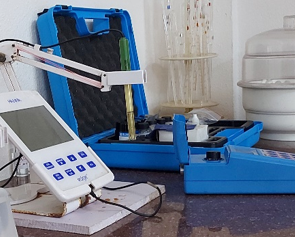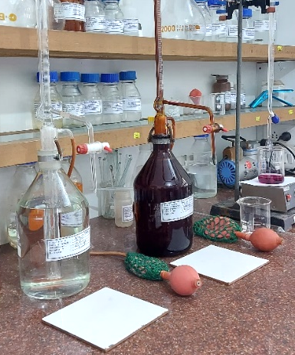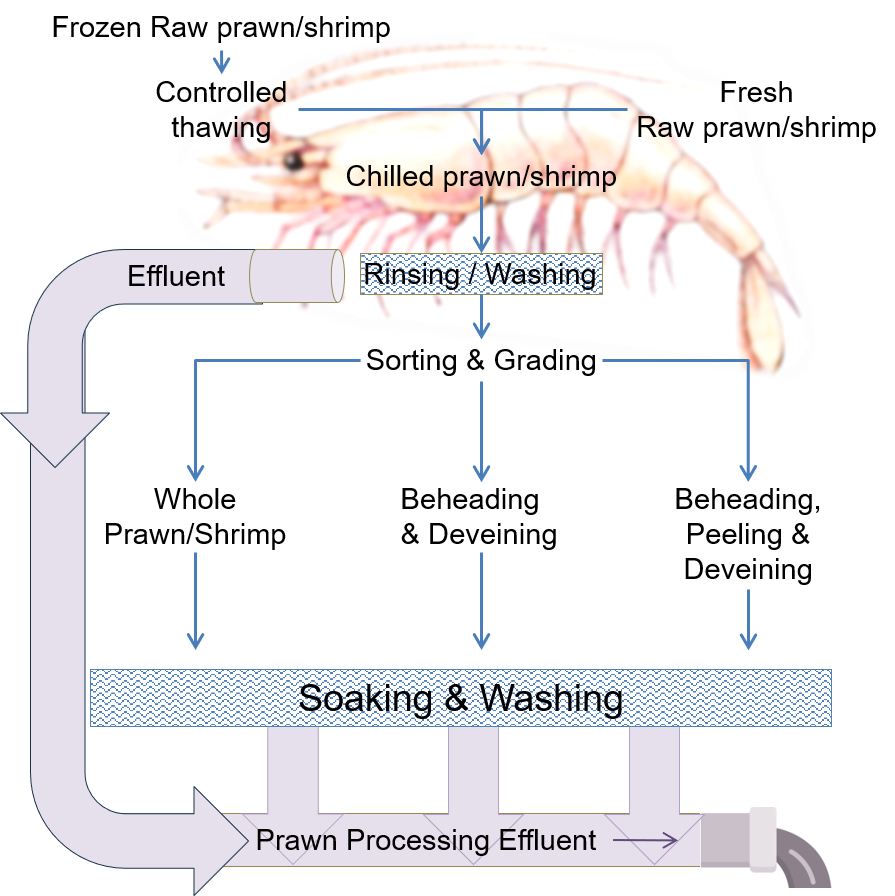Prawn/shrimp Processing Effluent tests (PPE)
Scope:

Physical & Sensory Parameters:
pH Value, Total Suspended Solids (TSS) & Total Dissolved Solids by Gravimetry (TDSG).

Chemical Parameters:
Total hardness of water (THW), Calcium (Ca) & Magnesium (Mg); Nitrate (NO3); Chloride, Phosphate, Total Oil & Grease (TOG), Chemical Oxygen Demand (COD) & Biochemical Oxygen Demand (BOD).
Total parameters: 3 + 9 = 12
Rationale:
Prawn is a shellfish with ten legs (decapods) and a long tail. Shrimp looks like a prawn but smaller. In fact, prawns and shrimps belong to two different sub-orders. Shrimps are comparatively softer and more flexible compared with prawns. Both prawns and shrimp can come from fresh and salt water bodies and can live in both warm and cold waters. Prawns and shrimps are quite popular food items and the demand for processed prawns/shrimps is increasing. The two terms, prawn and shrimp are often used interchangeably.

Prawns harvested from fishponds or caught from the seas are usually packed with crushed ice in insulated containers and transported to processing plants. Processing plants situated nearby prawn farming ponds may receive fresh prawn without any freezing. Frozen raw prawns received in ice containers are gradually thawed, so that the raw material is chilled enough to minimise decomposition and at the same can be handled for further processing. On the other hand, fresh raw prawns directly received from nearby fishponds are chilled to slow down decomposition during the course of processing. After rinsing and/or washing in clean (potable) cold water, prawns are sorted and graded. Shrimps are graded according to size. Bruised and discoloured prawns are discarded, pieces of which would be washed down along with processing plant effluent.
Based on grading and production plan of the plant, some prawns would be packed whole, some would be packed after removal of head & vein (headless prawns). Other batches would have the head removed, shells peeled and deveined (peeled & deveined prawns). Some other batches would have the head, shell and vein is removed except the shell on last segment and tail (Fantail & deveined). Some batches of prawn/shrimp products may be partially cooked. As processing progresses form one step to another, the product is soaked in water with additives, rinsed and/or washed in clean water, producing large volume of effluents. The prawn processing effluent contains large amounts of organic matter, small particles of flesh, soluble proteins and carbohydrates, all of which tend to increase biochemical oxygen demand (BOD). Untreated prawn processing effluent may contain high amounts of nutrients such as nitrogen and phosphorous, which can cause eutrophication of surface water bodies receiving such effluent.
Environmental Guidelines for Discharge of Effluents to Public Sewers and Surface Water Bodies:
The General Standards for Discharge of Environmental Pollutants Part-A: Effluents issued by the Central Pollution Control Board (CPCB) would be relevant for discharge of prawn/shrimp processing plant effluent to inland surface water bodies such and streams, rivers, lakes and reservoirs and to public sewers. This table lists 39 parameters. However, many of the listed parameters may not be of relevance for monitoring prawn processing plant effluent. Table 1 includes selected parameters from the general standard, that may of relevance for routine monitoring of prawn processing plant effluent meant to be discharged to inland water bodies or public sewers.
| Sl | Parameter | Unit | Inland Surface Water | Public Sewers | |
|---|---|---|---|---|---|
| pH | pH Value | 5.5 to 9.0 | 5.5 to 9.0 | ||
| Total Suspended Solids | mg/L | ≤ 100.0 | ≤ 600.0 | ||
| Ammoniacal Nitrogen as N | mg/L | ≤ 50.0 | ≤ 50.0 | ||
| Total Kjeldahl Nitrogen | mg/L | ≤ 100.0 | |||
| Phosphates as P | mg/L | ≤ 5.0 | |||
| Sulphide as S | mg/L | ≤ 2.0 | |||
| Total Oil & Grease | mg/L | ≤ 10.0 | ≤ 20.0 | ||
| Chemical Oxygen Demand (COD) | mg/L | ≤ 250.0 | |||
| Biochemical Oxygen Demand (BOD) | mg/L | ≤ 30.0 | ≤ 350.0 | ||
| Source:https://cpcb.nic.in/GeneralStandards.pdf | |||||
| Sl | Parameter | Unit | Inland Water Source (Creeks & Estuaries) |
Coastal Marine Waters |
|---|---|---|---|---|
| pH | pH Value | 6.5 - 8.5 | 6.5 - 8.5 | |
| Total Suspended Solids | mg/L | ≤ 100 | ≤ 100 | |
| Ammoniacal Nitrogen as N (Free Ammonia) | mg/L | ≤ 0.5 | ≤ 1.0 | |
| Nitrate - Nitrogen | mg/L | ≤ 0.5 | ≤ 1.0 | |
| Total Nitrogen as N | mg/L | ≤ 2.0 | ≤ 2.0 | |
| Dissolved Phosphates as P | mg/L | ≤ 0.2 | ≤ 0.4 | |
| Dissolved Oxygen (DO) | mg/L | ≥ 3.0 | ≥ 3.0 | |
| Chemical Oxygen Demand (COD) | mg/L | ≤ 75.0 | ≤ 100.0 | |
| Biochemical Oxygen Demand (BOD) | mg/L | ≤ 20.0 | ≤ 50.0 | |
| Source: Table under clause 10(3) of Guidelines for Regulating Coastal Aquaculture, issued by Government of India in pursuance of section 3 of the Coastal Aquaculture Authority Act, 2005 read with clause 3(a) of Coastal Aquaculture Authority Rules, 2024; The Gazette of India Extraordinary Part II – Section 3 – Sub-section (ii), dated 20th March 2024. | ||||
Sample - Collection, Storage & Transportation:
Follow methods of sampling specified in IS3025pt1:1987 for chemical tests and in IS 1622 : 1981 for bacteriological tests. Use a 1L clean and dry clear or amber colour glass or polypropylene bottle (CBWS / ABWS) for chemical lab sample, and a 250 ml clean sterile bottle (CSB) for bacteriological sample. Collect from the raw effluent pipe before wastewater treatment plant or treated effluent pipe after wastewater treatment, as required.
Information About Source, Context, Intended Use & Concerns:
Provide as much detail as you can about the location of the concerned RO plant, date and time of sample collection, etc.
Test Method & Duration:
Physical and chemical characteristics of water sample are tested according appropriate parts of the IS3025 and/or American Public Health Association (APHA). Test report will be available in 4 to 5 days.



To pick up sample collection bottle and/or schedule collection of samples: Email: ihslab@ihs.org.in with your address and contact telephone; OR WhatsApp: +919848011251; Or Call: 23211013/4.
References:
- CPCB. General Standards for Discharge of Environmental Pollutants Part-A: Effluents. Rule 3A Schedule-VI in: GoI. The Environment (Protection) Rules. New Delhi: Ministry of Environment and Forests (MoEF), Government of India (GoI); 1986. https://cpcb.nic.in/GeneralStandards.pdf
- Ning Robert Y. Chemistry in the Operation and Maintenance of Reverse Osmosis Systems. Chapter 4 in: Ning Robert Y. Advancing Desalination. London: Intech Open; 2012 Sep 14; pp. 85-95. https://www.intechopen.com/chapters/37328
- Vaishnav Jyoti; Soloman Prama Esther; Lal Chhagan, and Jain Pankaj Kumar. RO Reject Water Characteristics, Environmental Impacts and Management. Jurnal Kejuruteraan. 2023; 35(3):557-566. https://journalarticle.ukm.my/22174/1/kjt_3.pdf
- Ayers RS and Westcot DW. Water quality for agriculture. Rome, Italy: Food and Agriculture Organization of the United Nations (FAO); 1985. https://www.fao.org/4/T0234e/T0234e00.htm
- Lee Hwan; Jeon Dongho; Song Haemin; Sim Sung Won; Kim Dohoon; Yu Joan; Cho Kyung Hwa, and Oh Jae Eun. Recycling of Reverse Osmosis (RO) Reject Water as a Mixing Water of Calcium Sulfoaluminate (CSA) Cement for Brick Production. Applied Sciences. 2019; 9(23):5044. https://www.mdpi.com/2076-3417/9/23/5044
- Sanchez AS; Nogueira IBR, and Kalid RA. Uses of the reject brine from inland desalination for fish farming, Spirulina cultivation, and irrigation of forage shrub and crops. Desalination. 2015 May 15; 364:96-107. https://doi.org/10.1016/j.desal.2015.01.034
